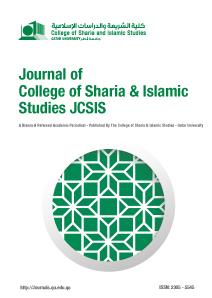The Interfaith Dimension of Some Recent English Translations of the Quran: A Critical Analysis
Abstract
Purpose: The objective of the paper is to explore the Interfaith dimension, if any, in select English translations of the Quran. Are these translations addressed only to the Muslim readership? Do these capture and convey the universal message of the Quran, which is directed at Muslims and non-Muslims alike? Since this aspect of the English translations of the Quran has been hardly explored, this study is an attempt to fill this gap. It will help readers realize the relative strengths and weaknesses of various translation.
Methodology: Select English translations have been closely and critically analysed in terms of the quantum of their contribution to Interfaith understanding. Some translations stand out on this count while others lack this dimension. So it is based on both inductive and deductive approaches.
Findings: This paper first provides a critical, historical survey of the English translations of the Quran, namely, those by Alexander Ross (1649), George Sale (1734), J. M. Rodwell (1861), E. H. Palmer (1880), Richard Bell (1937-1939), A. J. Arberry (1955), N. J. Dawood (1956), Alan Jones (2007) and A. J. Droge (2014). This paper draws attention to the unpalatable note of polemics under the pretext of comparative religion in the Orientalists’ English translations of the Quran. Syed Ahmad Khan (1817-1898), however, set in motion a new trend in the field: interfaith understanding from the perspective of pluralism. This trend is reflected more sharply in the translations by Thomas Cleary (2004) and Safi Kaskas and David Hungerford (2016). Although in their fairly recent English renderings of the Quran, G. S. Reynolds (2018) and Jane McAuliffe (2017) promise to study the Quran from an interfaith dialogue perspective, they often revert to the polemical Orientalist stance of discrediting the Quran as a poor imitation of the Bible. This paper examines the 21st century English translations of the Quran by Thomas Cleary (2004), Safi Kaskas and David Hungerford (2016), G. S. Reynolds (2018) and Jane McAuliffe (2017).
Originality: This is the first study of its kind – assessing the select translations in term of their promotion of the ideals of peaceful coexistence as spelled out by the Quran.
Metrics
##plugins.themes.bootstrap3.article.details##
InterfaithEnglish translations of the QuranOrientalistscomparative religion
• Ali, Muhammad Mohar, The Quran and the Orientalists, Norwich, UK, Jamiyat Ihyaa Minhaaj al- Sunnah, 2004.
• Bell, Richard and Watt, M.W., “The Quran and Occidental Scholarship” in Introduction to the Quran, Edinburgh, Edinburgh University Press, 1970, 173-186.
• Faris, Nabih Amin, “The Quran by Richard Bell,” The Muslim World, 28(4):1938, pp. 400-416
• Greifenhagen, F. V., “Traduttore traditore: An Analysis of the History of English Translation of the Quran,” Islam and Christian-Muslim Relations, 3(2):1992, pp. 274-291
• Hammad, Ahmad Zaki, “Representing the Quran in English”, The Gracious Quran: A Modern-Phrased Interpretation in English, Lisle, LA, USA, Lucent, 2007, 67-87.
• Khalifa, Mohammad, “English Translations of the Quran” in his The Sublime Quran and Orientalism, London, Longman, 1983, 64-79.
• Kidwai A. R., “Arberry’s The Koran Interpreted”, Hamdard Islamicus, 10:3, (1988), 71-75.
• Kidwai Abdur Raheem, Translating The Untranslatable A Critical Guide to 60 English Translations of the Quran, New Delhi: Sarup Book Publishers, 2011
• Kidwai, Abdur Raheem, “Arberry’s English Translation of the Quran: An Assessment,” Insight Islamicus, (6):2006, pp. 6-15.
• Majid, M.a, and Amene, S.b, “Comment Blachere compiled the Qur’an and its relation to the assignment of distorting the Quran (reviews and criticism)”, Asian Social Science, Vol. 12, Issue 6, June 2016, Pages 55-60.
• Manzoor, S. Parvez, “Method Against Truth: Orientalism and Quranic Studies”, Muslim World Book Review, 7:4, (1987), 33-49.
• Merril, J. E., “Dr. Bell’s critical Analysis of the Quran” Muslim World, 37(1947), 134-148.
• Mohammed, Khaleel, “Assessing English Translations of the Quran”, Middle East Quarterly 122, (Spring 2005), 58-71.
• Mollanazar, Hussein and Mohaqeq, Mohammad, “The Holy Quran: Translation and Ideological Presuppositions,” Translation Studies, 2(11):2005, pp. 59-65.
• Nadvi, Abdullah Abbas, Translations of the Meanings of the Holy Quran and the Development of Its Understanding in the West, Makkah, Muslim World League, 1996.
• Nykl, A.R., “Notes on E.H. Palmer’s The Quran”, Journal of the American Oriental Society, 56(1936), 77-84.
• Rippin, A., ‘Reading the Quran with Richard Bell’, Journal of the American Oriental Society, Ann Arbor, MI, 112:4, 1992, 639-47.
• Shah. M.S., “Edward William Lane on interpreting the Holy Qur’an”, Islam and Christian-Muslim Relations, Vol. 21, Issue 3, 2010, Pages 287-297.
• Shah, Muhammad Sultan, “A Critical Analysis of the Quranic Translation by George Sale,” The Islamic Quarterly, 54(2):2010, pp. 103-121
• Speight, E. E., “Marmaduke Pickthall,” Islamic Culture, (10):1936, pp. 337-338
• Wahiduddin, S., “Richard Bell’s Study of the Quran: A Critical Analysis’ Islamic Culture, 30(1956),263-272.


